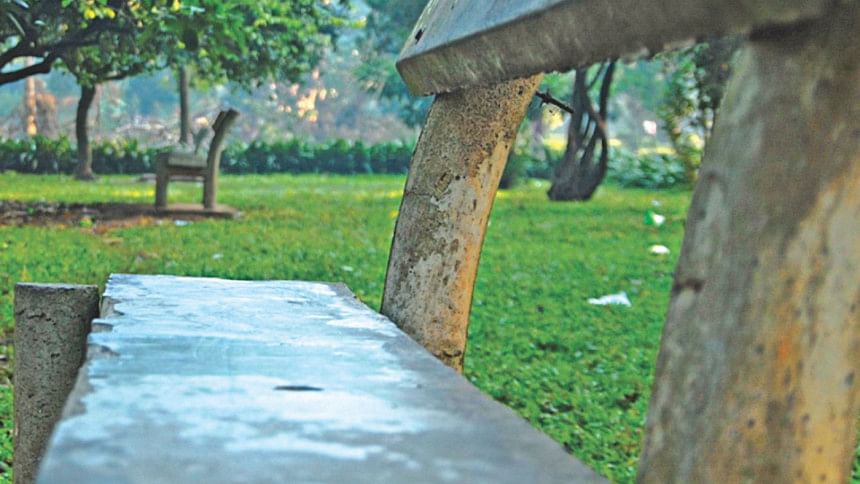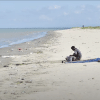Ecological havoc in Dhaka

DHAKA is faced with many direct threats to biodiversity with accelerating economic development, growing population, land grabbing, congested housing, tree felling, and vehicles emitting toxic fumes leading to extreme pollution and poor quality of life.
As early as 1991 Jica stated that the city failed to provide the appropriate number of parks and open spaces. Approximately 500 acres of land is maintained by the two City Corporations and PWD and this is much less than required.
Many parks and playing fields have vanished. Just to cite some examples, the Anwara Udyan, Armanitola Playing field, Tikatuli Park and Azimpur Park have almost disappeared. Shaheed Park of Mohammadpur has been gulped as has the Uttara Park of Sector 1. Many like Nawabganj Park, Lalmatia New Colony Park on Iqbal Road are occupied, while Jatrabari Crossing Park is used for housing and garbage.
The open spaces in Mirpur, Gulshan and Uttara were designed according to planning standards. But most have been illegally encroached. The playing field near Gulshan 1 has vanished. A section of Ramna Park has been taken by the Tennis Complex. Many parks are not maintained and have become dumping grounds for garbage. For instance, where are Bakshi Bazar Children's Park, Banani Amtali Park or Hazaribagh Park?
One recent disastrous aspect of development by the North City Corporation (NCC) included cementing green spaces surrounding houses, offices and shops in Gulshan, Banani and other areas. Many old trees, beneficial to health and well being, were cut including 10 trees outside the boundary wall of our residence while I was away. A once verdant green space is now hard concrete. Sewerage and road improvement has killed thousands of trees on road sides and islands.
Cement in front of houses, banks and offices reflect heat. According to a WHO report, excessive heat cost the lives and health of almost half a million people in Dhaka city alone.
Do we pay tax to the City Corporations to worsen our lives?
Dhaka ranks 169 out of 178 countries in terms of air quality in the Environmental Performance Index (2014). Trees clean the air of a highly polluted city, decrease pollution, increase well being and beauty in a cost effective way. So when trees are gone the opposite happens.
In 1960 Singapore's population mushroomed but there were few trees. The government took an initiative to plant trees. Concrete and asphalt were replaced with trees. The "aeration" programme found spaces for trees and to minimise disturbance to the root systems while replacing cables, sewerage lines etc. Even car parks were planted with trees to reduce asphalt surface and paved with perforated slabs to allow flow of air and water drainage.
Research reveals (BBC) that a tree reduces particulates by 7 percent to 24 percent. The cooling effect can be as high as 2 degrees Celsius. Even if trees are dispersed they cool the air by 0.5 to 2 degrees Celsius. While the health benefits of a clump of trees is greater, even a few trees will improve air quality and reduce stress.
Trees provide shade, soak pollution, release water vapour and cool down heat waves. They absorb fine particulates which wreak havoc on human beings and kill some 3.2 million people worldwide annually. Trees improve air quality in their immediate vicinity of around 100 feet area.
With this in view, I went around some areas of North and South City Corporation areas finding small and big open spaces recently cemented or areas filled with rubbish or wet earth where mosquitoes and flies buzzed. Pollution was excessive.
So what is stopping us from planting trees? The collaboration between the department of environment and that of public health is not present. Required government law is absent. More parks and a "Tree Planting Campaign" by all relevant government agencies could be the smartest investment for our polluted city.
Specific trees have to be selected for absorbing heat, pollutants and provide pleasant greenery. The London Plane trees are known for absorbing pollution and providing beauty and well being. In Bangladesh, Bougainvillea, Manila palm, debdaru, tamarind, mango, pippal, acacia, segun, neem, jackfruit, rain tree (rendi koral), shimul, banyan and mahogany etc. can be planted.
Neighbourhood trees and parks prompts people to greater physical activity leading to better physical health, reducing obesity, osteoporosis, diabetes, improving mental health and well being. Even trees in small urban green space can buffer the noise of cars, construction work and help in reducing morbidity. The small dirty nooks and muddy areas in every locality need to be cleaned and trees planted and maintained by the government along with communities. The available evidence from WHO suggests that other than playing fields, parks and even small, local green spaces close to where people live provide mental relaxation. Also, during rains the water can seep down into the ground raising the water table.
The glass enclosed massive BGMEA building near Sonargaon Hotel was illegally built on government land. Demolition order from the Court has been issued and as soon as it is demolished the area could be covered with trees and a small park. BGMEA is delaying the demolition using lame excuses. Will this demolition take place or will corruption get the upper hand?
The congested city of Tokyo has demonstrated that association with trees and parks results in beneficial immune responses and increased immunity. Studies have shown an increase of five years survival of individuals aged over 70 was positively associated with green tree spaces, maintaining trees and walking in parks.
Do we not want to live longer with less stress in a pleasant, greener environment?
Selina Mohsin is a former ambassador.










Comments